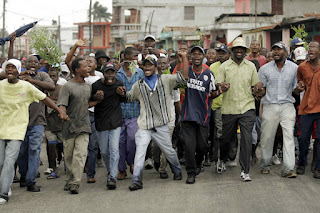Even though millions have found a
way out of extreme poverty, over 1
billion people remain stuck there. Why?
Some suggest “the poor are lazy” and others say “the rich are exploiting
the poor.” While there are instances of
these, experts believe the problem is much deeper and more complex.
 |
| Building HOLD the children Home, Lavaud, Haiti. |
 |
| Protesting few jobs, little food, and corrupt government. |
Leading
development thinkers have suggested the poor are “trapped” in poverty. Paul Collier states, “All societies used to
be poor. Most are now lifting out of it;
why are others stuck? The answer is traps”
[The Bottom Billion: Why the Poorest Countries Are Failing and What Can Be
Done About It (New York: Oxford University Press, 2007), 5]. Collier
suggests four: the conflict trap, the natural resources trap, the trap of being
landlocked with bad neighbors, and the trap of bad governance in a small
country.
As one of the world’s leading
economist, Sachs says society’s economic system has too many moving parts to
blame any one thing for poverty. He
lists eight traps to explain why some countries fail.
1. Poverty
Trap. “When poverty is very extreme,
the poor do not have the ability – by themselves – to get out of the mess.”
2. Physical
Geography. Some countries have great
natural resources – others are not so favored.
“Adverse geography poses problems that can be solved, typically through
physical investments and good conservation.”
3. Fiscal
Trap. When a government is too poor
to invest in infrastructure due to a poor populace, or an inept or corrupt
government, and – or the government is already carrying a tremendous debt load
called “debt overhang.”
4. Governance
Failures. For an economy to prosper
the government must provide infrastructure, internal peace and safety, maintain
a judicial system and defend its national territory. “Economic development requires a government
oriented toward development.”
5. Cultural
Barriers. Cultural or religious practices that block the role of women, for
example, to be without economic or political rights or education undermines
overall development.
6. Geopolitics.
“It takes two to trade. Trade barriers
erected by foreign countries can impede a poor country’s economic development.”
7. Lack
of Innovations. Impoverished countries lack capital (either financial or
human) for market production. Rich
countries have large markets and capital to fuel innovation. “This momentum creates, in effect, a chain
reaction, which economists call endogenous growth.”
8. Demographic
Trap. When poor families have many children problems are compounded. “When impoverished families have large
numbers of children, the families cannot afford to invest in the nutrition,
health, and education of each child…. High population growth leads to deeper
poverty, and deeper poverty contributes to high fertility rates [Sachs, The
End of Poverty, 56].